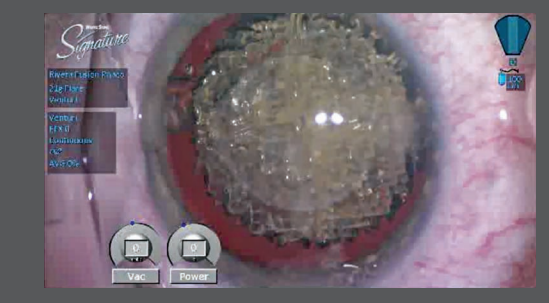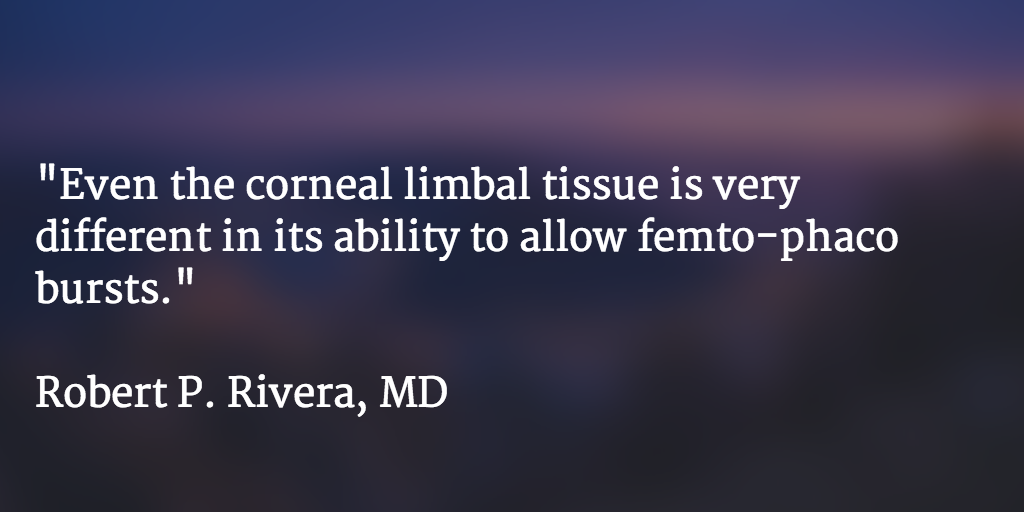Article
Femtosecond laser technology helps achieve ‘napkin’ capsulotomy
When a capsulotomy is completely separated from the anterior capsule, or free floating, surgeons can simply grasp the capsule and lift it from the eye-literally as easy as lifting a napkin up from a table-thus the “napkin” capsulotomy.
Take-home message: When a capsulotomy is completely separated from the anterior capsule, or free floating, surgeons can simply grasp the capsule and lift it from the eye-literally as easy as lifting a napkin up from a table-thus the “napkin” capsulotomy.
By Robert P. Rivera, MD, Special to Ophthalmology Times
Sandy, UT-All corneas are not created equally. The advent of femtosecond laser cataract surgery has helped cataract surgeons to make remarkable strides in the level of precision and to achieve near-perfect capsulotomy completion rates.
More from OT: Defending adjustable sutures in strabismus surgery

Femtosecond lasers benefit cataract surgery by fragmenting the lens, performing capsulotomy, and creating accurate incisions for the correction of astigmatism, as well as entry and sideport incisions. Surgeons are able to perform capsulotomy with excellent results that lift cleanly and easily, increasing the likelihood that the remainder of the procedures will be smooth, easy, and predictable.
In ideal circumstances, the femtosecond laser should reduce the occurrence of simple complications, such as anterior capsular tear, to the more severe problem, such as a dropped nucleus following a radial tear in the posterior capsule. Surgeons must learn to control those circumstances to enhance rates of success.
A weak capsulotomy matters
Femtosecond laser energy passes through tissue in rapid, tiny microbursts. Consequently, the laser energy is also easily deflected by any tissue irregularities or obstructions.
Next: 'Variations in the cornea can potentially be magnifed'
Variations in the cornea can potentially be magnified, in effect causing changes in the laser beam pulse as it travels through an irregular area. Dust on the laser lens, natural or pathological imperfections in the tissue, and particles or air bubbles in the fluid interface can all have similar effects of deviating or absorbing some of the laser energy through the cornea.
Even the corneal limbal tissue is very different in its ability to allow femto-phaco bursts.
Thus, the capsule areas behind these corneal irregularities are often left with skipped lesions, or “tags” in places where the perforation of the capsular tissue was incomplete.
If surgeons are manipulating the cataract inside the capsular bag, or placing an IOL into the capsular bed, it must be ensured that the capsulotomy edge is strong enough to avoid creating an anterior capsular tear. Skipped lesions reduce capsulotomy strength and can lead to complications during removal-such as radial tear or weakening-ultimately slowing the procedure and heightening the risk for the tear to continue into the posterior capsule.

Capsular weakness or tears can also result in dislocated IOLs. Proper centration is particularly important when implanting a toric or other premium IOL, and may force a change in the IOL lens choice.
For instance, a capsular tear increases the risk of decentration of a one-piece toric lens, so an alternate choice must be made on the spot. A complete, free-floating capsulotomy with edges devoid of any weakening caused by tears ensures that the capsule is strong enough to tolerate manipulation.
Next: Achieving the ‘napkin’ capsulotomy
With a goal of producing free-floating capsulotomies for every cataract case, anything that could affect the outcome of surgery must be taken into account.
Further reading: Future of digital lens design
To mitigate the possibility of an incomplete capsulotomy, note any areas of the cornea that appear hazy or irregular and identify small scars and even tiny imperfections possibly caused by previous foreign body or pterygium excision. If corneal changes or defects are detected, I increase the femtosecond laser parameters to ensure sufficient energy fires through the imperfection to achieve complete perforation.
Another significant factor in achieving a free-floating capsulotomy is the use of a liquid-optics docking interface (Catalys, Abbott Medical Optics). A liquid-bath interface allows the cornea to remain in its pristine state without applanation or flattening, and the cornea remains devoid of induced corneal folds or ridges.
When a capsulotomy is completely separated from the anterior capsule, or free floating, surgeons can simply grasp the capsule and lift it from the eye-literally as easy as lifting a napkin up from a table-thus the “napkin” capsulotomy.
Lens removal
The ability of the femtosecond laser to fragment the cataract into a grid pattern reduces the amount of manipulation and phacoemulsification energy required to break down and aspirate the lens. The small fragments flow easily into the vacuum without clogging the tip.
Next: Switching 'on the fly'
One phacoemulsification platform (Whitestar Signature Phacoemulsification, Abbott Medical Optics) allows me to switch “on the fly” between the traditional flow-based peristaltic and vacuum-based venturi pumps. Prior to incorporating the femtosecond laser into practice, I looked for simplicity in both my approach to lens removal and the features of the equipment believed necessary to successfully perform the emulsification process.
As a minimalist in my approach, the use or necessity of the venturi vacuum has not been considered. However, because I had the capability, I decided to try the venturi aspect of the phacoemulsification system.
It was immediately evident that the venturi vacuum system was designed to complement the femtosecond laser. By applying the venturi system, I am able to evacuate lens fragments with even less phaco energy than what I previously was accustomed to when using the peristaltic pump.
Summary
A clean, complete capsulotomy significantly reduces the rate of complications and sets the stage for a smooth and predictable surgical procedure. The right equipment is the most important factor to ensuring this success.
Furthermore, utilizing machinery components developed to complement each other also adds to the ease and success of cataract removal and refractive outcomes.
Robert P. Rivera, MD, joined Hoopes Vision in 2011 where he became director of clinical research at Hoopes-Rivera Clinical Research Center, Sandy, UT. He died April 1, 2015 after a 6-month battle with cancer.
Newsletter
Don’t miss out—get Ophthalmology Times updates on the latest clinical advancements and expert interviews, straight to your inbox.





